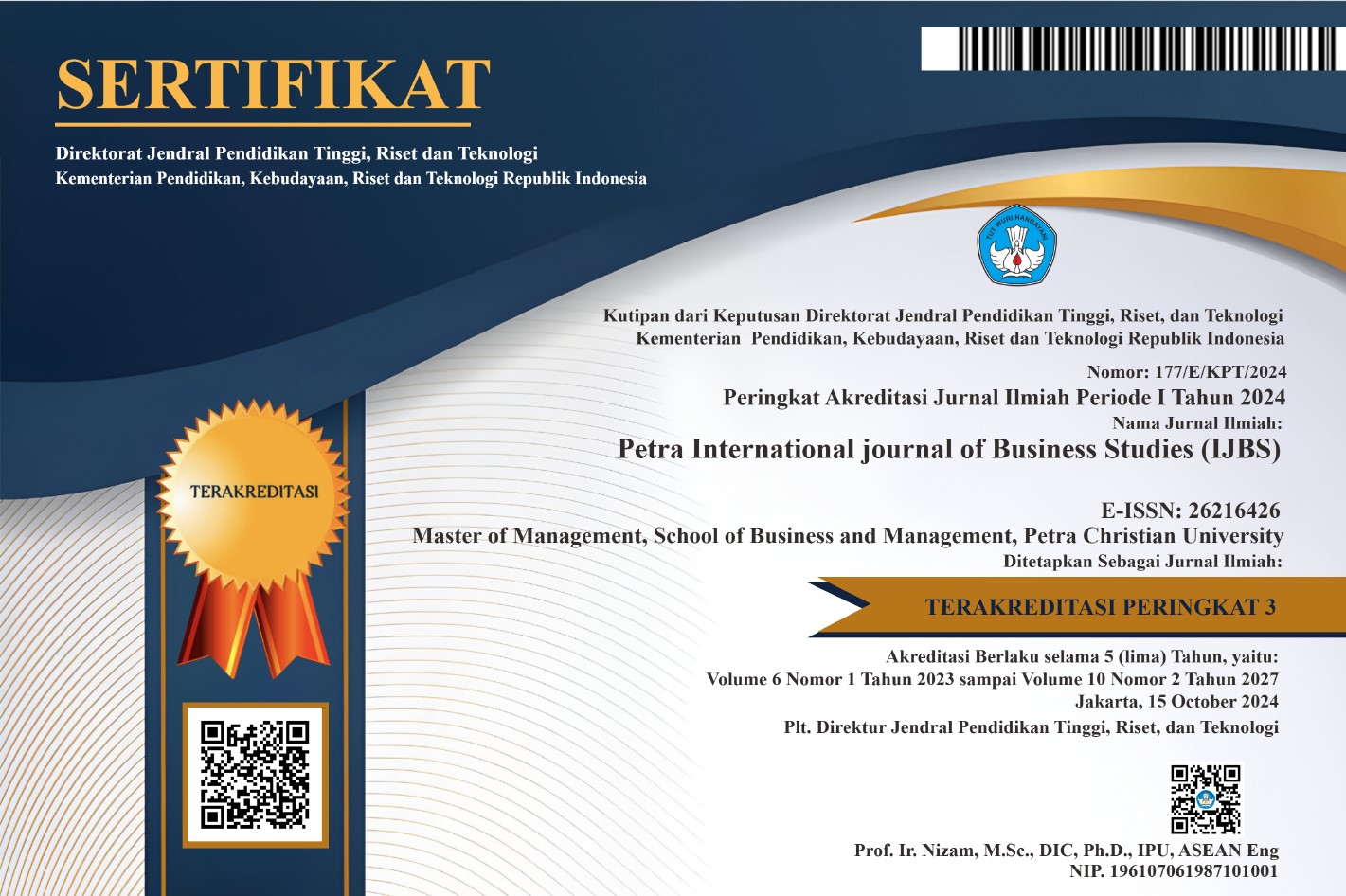Analysis of The Influence of Supplier and Government Partnerships on Hospital Supply Chain Performance
DOI:
https://doi.org/10.9744/petraijbs.7.1.99-112Keywords:
Hospital Supply Chain, Supply Chain Partnerships, System Dynamics Modeling, Hospital Supply Chain PerformanceAbstract
Indonesia's healthcare industry has expanded rapidly alongside population growth to 278 million by 2023, driving a notable increase in healthcare expenditure. Hospitals form the backbone of healthcare provision, Within the complex landscape of the healthcare industry, the hospital supply chain (HSC) is crucial for ensuring the timely delivery of medical resources. Partnerships may play a crucial role in improving an HSC’s overall performance. This study employs System Dynamics modeling to analyze the impact of supplier and government partnerships on HSC performance. The study extends the existing literature by incorporating both CLD and SFD methodologies to provide a more comprehensive analysis of the factors and intricacies within hospital supply chain partnerships. The findings indicate that high trust, IT integration, and hospital dynamic capabilities improve hospital supply chain performance through better information sharing and integration. Hospital demand significantly influences government regulations and control, further affecting performance. Theoretically, this study advances how dynamic interactions and feedback loops between multiple stakeholders within the HSC can be effectively modeled to gain insight and enhance healthcare supply chains.
Downloads
References
Abdallah, A. B., Abdullah, M. I., & Mahmoud Saleh, F. I. (2017). The effect of trust with suppliers on hospital supply chain performance: The mediating role of supplier integration. Benchmarking, 24(3), 694–715. https://doi.org/10.1108/BIJ-05-2016-0062
Alshahrani, S., Rahman, S., & Chan, C. (2018). Hospital-supplier integration and hospital perfor-mance: Evidence from Saudi Arabia. Inter-national Journal of Logistics Management, 29(1), 22–45. https://doi.org/10.1108/IJLM-12-2016-0287/FULL/XML
Amissah, M., Gannon, T., & Monat, J. (2020). What is systems thinking? expert perspectives from the WPI Systems Thinking Colloquium of 2 October 2019. Systems 2020, 8(1), 6. https://doi.org/10.3390/ SYSTEMS8010006
Ariesty, W. (2016). The influence of supplier trust and supplier commitment to supplier performance through information sharing and collaboration. Jurnal Manajemen dan Kewirausahaan, 18(1), 60–70. https://doi.org/10.9744/JMK.18.1.60-70
Baugh Littlejohns, L., Hill, C., & Neudorf, C. (2021). Diverse approaches to creating and using Causal Loop Diagrams in public health research: recommendations from a scoping review. Public Health Reviews, 42, 1604352. https://doi.org/ 10.3389/PHRS.2021.1604352/BIBTEX
Dobrzykowski, D. (2019). Understanding the downstream healthcare supply chain: unpacking regulatory and industry characteristics. Journal of Supply Chain Management, 55(2), 26–46. https://doi.org/10.1111/JSCM.12195
Jaya. (2023, July 31). Laporan akuntabilitas kinerja instansi pemerintah semester 1. Retrieved from Https://E-Renggar.Kemkes.Go.Id/File_performance/3-466080-01-3tahunan-345.Pdf.
Kitsiou, S., Matopoulos, A., Manthou, V., & Vlachopoulou, M. (2007). Evaluation of inte-gration technology approaches in the healthcare supply chain. International Journal of Value Chain Management, 1(4), 325–343. https://doi.org/10.1504/IJVCM.2007.015091
Malbon, E., & Parkhurst, J. (2023). System dynamics modelling and the use of evidence to inform policymaking. Policy Studies, 44(4), 454–472. https://doi.org/10.1080/01442872.2022.2080814
Maloni, M. J., & Benton, W. C. (1997). Supply chain partnerships: Opportunities for operations research. European Journal of Operational Research, 101(3), 419–429. https://doi.org/10.1016/S0377-2217(97)00118-5
Mandal, S. (2017). The influence of dynamic capabilities on hospital-supplier collaboration and hospital supply chain performance. International Journal of Operations and Production Management, 37(5), 664–684. https://doi.org/10.1108/IJOPM-05-2016-0249
Matopoulos, A., & Michailidou, L. (2013). Imple-menting collaborative practices in the healthcare supply chain: Insights into hospital-vendor operations. International Journal of Logistics Systems and Management, 15(2–3), 288–303. https://doi.org/10.1504/IJLSM.2013.053773
Mishra, V., Samuel, C., & Sharma, S. K. (2018). Supply chain partnership assessment of a diabetes clinic. International Journal of Health Care Quality Assurance, 31(6), 646–658. https://doi.org/10.1108/IJHCQA-06-2017-0113
Pan, J., Liu, G. G., & Gao, C. (2013). How does separating government regulatory and operational control of public hospitals matter to healthcare supply? China Economic Review, 27, 1–14. https://doi.org/10.1016/J.CHIECO.2013.07.002
RS Online. (n.d.). Retrieved February 8, 2024, from https://sirs.kemkes.go.id/fo/home/dashboard_rs?id=0
Sadya, & Bayu. (2023, April 11). Ada 3.072 Rumah sakit di Indonesia pada 2022. Retrieeved from Https://Dataindonesia.Id/Kesehatan/Detail/Ada-3072-Rumah-Sakit-Di-Indonesia-Pada-2022.
Schliephake, K., Stevens, G., & Clay, S. (2009). Making resources work more efficiently – the importance of supply chain partnerships. Journal of Cleaner Production, 17(14), 1257–1263. https://doi.org/10.1016/J.JCLEPRO.2009.03.020
Setiawati, M., Pasaribu, A., Halim, D. P., & Darmawan, J. (2023). Exploring hospital supply chain partnership factors and its impact on overall supply chain performance. Petra International Journal of Business Studies, 6(2), 213–225. https://doi.org/10.9744/PETRAIJBS.6.2.213-225
Setyawan Firmansyah, H., & Siagian, H. (2022). Impact of information sharing on supply chain performance through supplier quality management, supply chain agility, and supply chain innovation. Petra International Journal of Business Studies, 5(2),119–131. https://doi.org/10.9744/IJBS.5.2.119-131
Sodhi, M. M. S., & Son, B. G. (2009). Supply-chain partnership performance. Transportation Research Part E: Logistics and Transportation Review, 45(6), 937–945. https://doi.org/10.1016/J.TRE.2009.05.004
Sterman, J. D., Burr Ridge, B., Dubuque, I., Madison, I., & New York San Francisco St Louis Bangkok Bogota Caracas Lisbon London Madrid Mexico City Milan New Delhi Seoul Singapore Sydney Taipei Toronto, W. (2000). Business dynamics systems thinking and modeling for a complex world. Retrieved from http://www.mhhe.com
Additional Files
Published
Issue
Section
License
Copyright (c) 2024 Aiko Pasaribu, Roland Y. H. Silitonga, Marla Setiawati

This work is licensed under a Creative Commons Attribution 4.0 International License.
Petra IJBS (e-ISSN: 2621-6426) is published by Master of Management program, School of Business and Management, Petra Christian University, Indonesia (MM SBM PCU).












